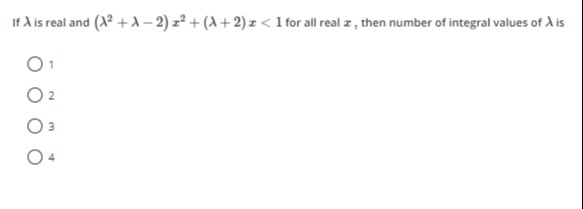Question
Question: If $\lambda$ is real and $(\lambda^2 + \lambda - 2)x^2 + (\lambda + 2)x < 1$ for all real $x$, then ...
If λ is real and (λ2+λ−2)x2+(λ+2)x<1 for all real x, then number of integral values of λ is

A
1
B
2
C
3
D
4
Answer
3
Explanation
Solution
The inequality can be rewritten as (λ2+λ−2)x2+(λ+2)x−1<0. For this quadratic inequality to hold for all real x, two conditions must be met:
- The leading coefficient must be negative: A=λ2+λ−2<0. Factoring gives (λ+2)(λ−1)<0, so −2<λ<1.
- The discriminant must be negative: D=(λ+2)2−4(λ2+λ−2)(−1)<0. D=(λ2+4λ+4)+4(λ2+λ−2)=5λ2+8λ−4. For D<0, we find the roots of 5λ2+8λ−4=0: λ=10−8±64−4(5)(−4)=10−8±144=10−8±12. The roots are λ=−2 and λ=2/5. So, D<0 when −2<λ<2/5. Combining the conditions for A<0 and D<0, we need −2<λ<1 and −2<λ<2/5. The intersection is −2<λ<2/5. The integral values in this range are −1 and 0.
We must also consider the case when the leading coefficient is zero: A=λ2+λ−2=0. This occurs when (λ+2)(λ−1)=0, so λ=−2 or λ=1.
- If λ=−2: The inequality becomes 0x2+(−2+2)x−1<0, which simplifies to −1<0. This is true for all x, so λ=−2 is a valid integral value.
- If λ=1: The inequality becomes 0x2+(1+2)x−1<0, which simplifies to 3x−1<0. This is not true for all x (e.g., x=1). So λ=1 is not valid.
The integral values of λ are −2,−1,0. There are 3 such values.
